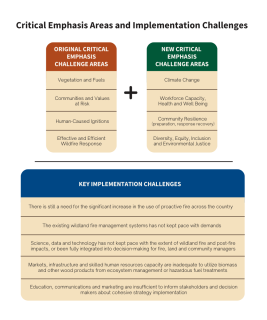Updates to Cohesive Wildland Fire Management Strategy set unified approach to wildfire management

WASHINGTON, DC—The Forest Service, along with its partners in the Wildland Fire Leadership Council, released an update to the National Cohesive Wildland Fire Management Strategy following a year-long refresh effort to review and identify new drivers impacting wildland fire. The Addendum Update builds on the original 2014 strategy and provides new guidance for addressing today’s wildfire challenges.
The Cohesive Strategy is a strategic push to work collaboratively among all stakeholders and across all landscapes, using best science, to make meaningful progress toward the newly updated three goals:
- Create fire-adapted communities
- Resilient landscapes
- Safe and effective risk-based wildfire response
While the implementation of the Cohesive Strategy may look different depending on where you work, the strategy itself remains the same. It challenges us to reach beyond individual, organizational and historical silos to collectively define and understand risk, set landscape-level and community-wide priorities, share and co-manage risk across boundaries and jurisdictions, accept some short-term risk for long-term benefit, and collectively invest in outcome-based approaches and activities, rather than outputs.
“This update comes at a pivotal moment as federal agencies, states, tribes and the private sector all ramp up work to meet the challenge of the wildfire crisis facing the nation. Building on the strong foundation of the original strategy and synthesizing nine years' worth of research, this update elevates critical issues like climate change, and it defines key challenges that affect all agencies,” said Deputy Under Secretary Meryl Harrell, Natural Resources and Environment, U.S. Department of Agriculture. “This vision will fuel collaboration and help guide how we plan, implement and evaluate work in wildfire.”
Changes in the Cohesive Strategy
In addition to the updated goals, the vision of the strategy was also updated to more accurately represent a well-rounded approach to managing wildfire.
Updated vision statement: “Safely and effectively extinguish fire, when needed; use fire where allowable; manage our natural resources; and collectively, learn to live with wildland fire.”
Other changes include four new critical emphasis areas that are significantly affecting the behavior, duration and impacts of wildland fire. Five key challenges to implementing the Cohesive Strategy were also identified.
The Addendum Update, together with the 2014 National Cohesive Wildland Fire Management Strategy, are considered merged as the Cohesive Strategy going forward.
The Cohesive Strategy and its new addendum give us the framework and allow for maximum flexibility to address today’s rapidly changing wildland fire environment.
To learn more about the National Cohesive Wildland Fire Management Strategy, visit https://wildfireinthewest.org/about/.


